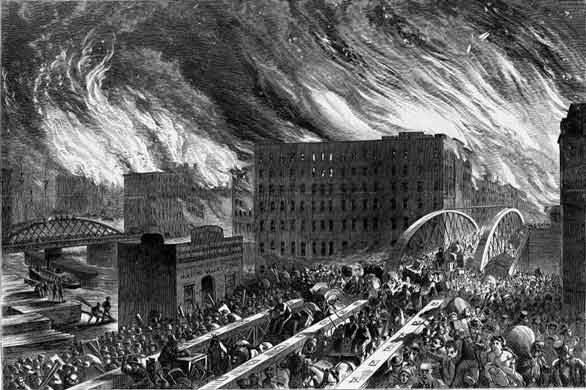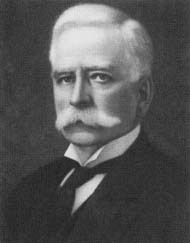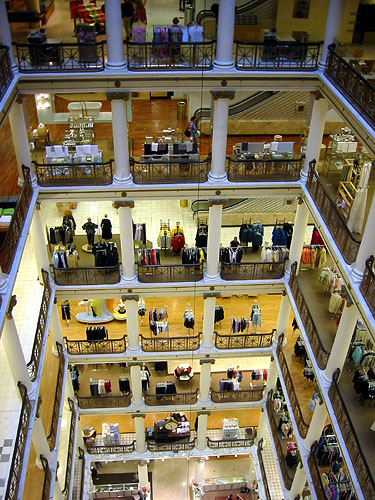
"Chicago in Flames -- The Rush for Lives Over Randolph Street Bridge", John R. Chaplin, Harpers Weekly, 1871
A story of disaster and resilience not often told outside historic downtown Chicago is the story of the Great Chicago Fire and the legendary retailer who rose from it's ashes.
An inferno of biblical proportions, the Great Chicago Fire burned from "Sunday, October 8, to early Tuesday, October 10, 1871, killing hundreds and destroying about 3.3 square miles in Chicago, Illinois."[1]
Popular lore as to the cause of the fire remains the "O'Leary Cow-Milking Tale", which describes a cow kicking over a kerosine lantern while being milked. Hay feed quickly caught fire as a result, and an entire barn was engulfed within minutes. Nearby wooden structures began burning, and due to the city's overuse of wood in construction (buildings, sidewalks, etc.) nearly every piece of public and private infrastructure was fair game.
Flying embers gravitated from burning buildings to the city centers, setting fire to the great theaters, churches, mansions, and industrial parks. The fires even spread to the municipal waterworks, cutting off water supply to firefighters and all residents throughout the city. All attempts to stop the blaze failed.

Marshall Field
Word of the encroaching flames reached Marshall Field, partner in a modest retail store in downtown Chicago, Field & Leiter. He and his associates acted quickly and began loading store merchandise onto wagons, to be safely shipped outside the city. All night they labored, loading every crate and box of the store's lifeblood inventory, while fighting off flames with what little water supply remained. When the final box was loaded to safety, the entire building burst into flames, and the last remaining employee leaped out with his life in tact. [2]
That precious inventory provided Field and his associates with the capital they needed to return to Chicago's retail business with fury. But not before the great fires would wear themselves out.
Amid dying winds and light rains the fire ended on a Tuesday morning.
A group of merchants "Stood on State Street, looking at the smoking remains of what had been their stores." They conferred with one another on whether or not to stay and rebuild, or leave for another more promising part of the country, "They all reached a decision to leave," indicates Napoleon Hill, "Except for one man, who chose to stay...The merchant who decided to stay and rebuild, pointed at the remains of his store and said, 'Gentlemen, on that very spot I will build the world's greatest store, no matter how many times it will burn down.'"[3]

Marshall Fields Dept Store (Now Macy's)
That man was Marshall Field, and his new store served as the headquarters of Marshall Field and Company. It became a Chicago landmark, employing over 12,000, and was described by playwright Julian Leonard Street as the, "Largest, largest, largest" building in which he had ever stepped foot. He discovered there were, "Fifty acres of floor space under [one] roof…[with] sixteen floors: Thirteen stories rising two hundred and fifty-eight feet above the street, and three basements, extending forty-three and a half feet below." There was a "huge recreation room, gymnasium, and dining room, all for the use of the employees." His "quick tour" of the building took over two hours. [4]
The most fascinating aspect of this story may be that Field took advantage of a market that was truly devastated---and went on to become one of America's wealthiest men. It was his courageous action during and after the fires which built the foundation of a great American retailing group.
He ultimately died on January 16, 1906, roughly 35 years after the fire.
On the day of his funeral stores on Chicago's State Street closed, and the Chicago Board of Trade suspended afternoon trading in his honor. Shortly after his death, Marshall Field and Company reported sales figures north of $75 million---which in today's dollars is nearly $2 billion in sales.
In 2005, the historic Marshall Fields retail business was bought by Macy's.
References:
1. http://en.wikipedia.org/wiki/Great_Chicago_Fire
2. http://en.wikipedia.org/wiki/Marshall_Field
3. "Think and Grow Rich", by Napoleon Hill
4. "Abroad At Home", Julian Leonard Street
5. Photo sources 1, 2.





















